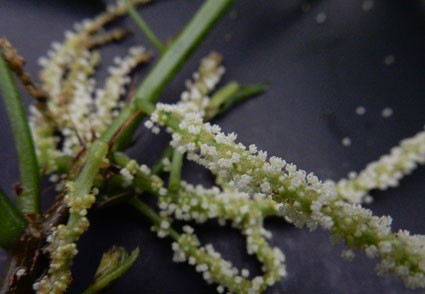Abstract
Acalypha amithii is described and illustrated as a new species from the State of Guerrero, Mexico. Its distribution is restricted to the Pacific slope. Acalypha amithii is morphologically close to the Mesoamerican A. ferdinandi and the South American A. stenoloba. However, it can be distinguished from the former by number of teeth in the bracts of the pistillate flowers (13–15 vs. 7 in the new species) and from the latter by the degree of fusion of the sepals of the pistillate flowers (connate at the base vs. free in the new species). Acalypha amithii is characterized by a suffruticose habit, penninerved leaves, terminal or axillary pistillate inflorescences, sepals of the pistillate flowers completely free and ovate-lanceolate, bracts of the pistillate flowers cuneate at the base, styles glabrous and almost 12 times longer than the ovary.
References
Cardiel, J.M. (2007) Catálogo de las especies peruanas de Acalypha Linnaeus (Euphorbiaceae). Fontqueria 55: 405–414.
Cardiel, J.M., Dorda, E., Muñoz, P. & Pardo de Santayana, M. (2008) Acalypha taxonomic information system. Facultad de Ciencias, Universidad Autónoma de Madrid, Madrid. Available from: http://www.acalypha.es/ (accessed 25 October 2021).
Cardiel, J.M., Nee, M. & Muñoz-Rodríguez, P. (2013) Synopsis of Acalypha L. (Euphorbiaceae) of Peru and Bolivia, with description of a new species. Anales del Jardín Botánico de Madrid 70: 152–177. https://doi.org/10.3989/ajbm.2366
Govaerts, R., Frodin, D.G. & Radcliffe-Smith, A. (2000) World Checklist and Bibliography of Euphorbiaceae (and Pandaceae). Royal Botanic Gardens, Kew, 1661 pp.
Linnaeus, C. (1753) Species Plantarum. L. Salvius, Stockholm, 1200 pp.
Martínez-Gordillo, M., Jiménez, J., Cruz, R., Juárez, E., García, R., Cervantes, A. & Mejía, R. (2002) Los géneros de la familia Euphorbiaceae en México. Anales del Instituto de Biología. Serie Botánica 73: 197–219.
McVaugh, R. (1961) Euphorbiaceae novae Novo-Galicianae. Brittonia 13: 145–205. https://doi.org/10.2307/2805352
Müller-Argoviensis, J. (1865) Euphorbiaceae. Vorläufige Mittheilungen aus dem für DeCandolle‘s Prodromus bestimmten Manuscript über diese Familie. Linnaea 34: 1–752.
Müller-Argoviensis, J. (1872) Euphorbiacearum species novae. Flora 55: 2–11, 24–28, 41–45.
Pax, F. & Hoffmann, K. (1924) Euphorbiaceae-Acalypheae-Acalyphinae-Additamentum VII-Phyllanthoideae-Crotonoideae. In: Engler, A. (ed.) Das Pflanzenreich IV. 147. XVI–XVII. Wilhelm Engelmann, Leipzig, pp. 1–231.
Radcliffe-Smith, A. (2001) Genera Euphorbiacearum. Royal Botanical Gardens, Kew, 455 pp.
Rzedowski, G.C. & Rzedowski, J. (2001) Flora fanerogámica del Valle de México. Instituto de Ecología A. C. & Comisión Nacional para el Estudio de la Biodiversidad, Patzcuaro, 1406 pp.
Schlechtendal, D.F.L. (1846 [1847]) Plantae Leiboldianae: Dicotyleae. Linnaea 19: 234–320.
Seberg, O. (1984) Taxonomy and phylogeny of the genus Acalypha (Euphorbiaceae) in the Galápagos Archipielago. Nordic Journal of Botany 4: 159–190. https://doi.org/10.1111/j.1756-1051.1984.tb01485.x
Standley, P.C. (1923) Trees and Shrubs of México. Contributions from the United States National Herbarium 23: 1–1721.
Steinmann, V.W. (2002) Diversidad y endemismo de la familia Euphorbiaceae en México. Acta Botánica Mexicana 61: 6193. https://doi.org/10.21829/abm61.2002.909
Tokuoka, T. (2007) Molecular phylogenetic analysis of Euphorbiaceae sensu stricto based on plastid and nuclear DNA sequences and ovule and seed character evolution. Journal of Plant Research 120: 511–522. https://doi.org/10.1007/s10265-007-0090-3
Webster, G.L. (1994) Synopsis of the genera and suprageneric taxa of Euphorbiaceae. Annals of the Missouri Botanical Garden 81: 33–144. https://doi.org/10.2307/2399909
Wurdack, K.J. & Davis, C.C. (2009) Malpighiales phylogenetics: Gaining ground on one of the most recalcitrant clades in the angiosperm tree of life. American Journal of Botany 96: 1551–1570. https://doi.org/10.3732/ajb.0800207


